Specific Absorption Rate Analysis of Wideband Multiple-Input Multiple-Output Antennas for Upper Mid-Band LTE 46/47 and n102 Future Generation Applications
Abstract
:1. Introduction
- We proposed a Pi-shaped ten-element MIMO antenna that consists of a decoupling structure that offers isolation of greater than −10 dB across the upper mid-band (LTE 46/47, n102), with a fractional bandwidth of 32.72%.
- SAR analysis: The maximum and minimum SARs observed in hand simulation for 1 g of tissue were 0.118 W/kg and 0.0606 W/kg, and the maximum and minimum SARs observed in the presence of head simulation for 10 g of tissue were 18.7 W/kg and 1.72 W/kg.
- The mutual coupling performance of the proposed ten-element antenna was examined, and the results show good values for the envelope correlation coefficient (ECC) < 0.03, which proves the appropriateness of the antenna for real-time diversity environments.
2. Antenna Design
2.1. Evolution of the Pi-Shaped Antenna Design
2.2. Optimization of Ground Slot Dimensions
2.3. Effect of Decoupling Structure
3. Results and Discussion
3.1. S-Parameters
3.2. Realized Gain
3.3. Total Efficiency
3.4. Radiation Pattern
Envelope Correlation Coefficient (ECC)
3.5. Diversity Gain
3.6. SAR Analysis
3.7. Comparison
4. Conclusions
Author Contributions
Funding
Data Availability Statement
Conflicts of Interest
References
- Zahid, M.N.; Gaofeng, Z.; Kiani, S.H.; Rafique, U.; Abbas, S.M.; Alibakhshikenari, M.; Dalarsson, M. H-Shaped Eight-Element Dual-Band MIMO Antenna for Sub-6 GHz 5G Smartphone Applications. IEEE Access 2022, 10, 85619–85629. [Google Scholar] [CrossRef]
- Kulkarni, N.; Linus, R.M.; Bahadure, N.B. A Small Wideband Inverted L-Shaped Flexible Antenna for Sub-6 GHz 5G Applications. AEU-Int. J. Electron. Commun. 2023, 159, 154479. [Google Scholar]
- Fang, Y.; Liu, Y.; Jia, Y.; Liang, J.; Zhang, H.H. Reconfigurable Structure Reutilization Low-SAR MIMO Antenna for 4G/5G Full-Screen Metal-Frame Smartphone Operation. Antennas Wirel. Propag. Lett. 2023, 22, 1219–1223. [Google Scholar]
- Desai, A.; Kulkarni, J.; Kamruzzaman, M.M.; Hubalovsky, S.; Hsu, H.-T.; Ibrahim, A.A. Interconnected CPW Fed Flexible 4-Port MIMO Antenna for UWB, X, and Ku Band Applications. IEEE Access 2022, 10, 57641–57654. [Google Scholar]
- Abubakar, H.S.; Zhao, Z.; Wang, B.; Kiani, S.H.; Parchin, N.O.; Hakim, B. Eight-Port Modified E-Slot MIMO Antenna Array with Enhanced Isolation for 5G Mobile Phone. Electronics 2023, 12, 316. [Google Scholar] [CrossRef]
- Shankar Das, G.; Bikash Chamuah, B.; Beria, Y.; Protim Kalita, P.; Buragohain, A. Compact Four Elements SUB-6 GHz MIMO Antenna for 5G Applications. Mater. Today Proc. 2023, in press.
- Kumar, P.; Pathan, S.; Kumar, O.P.; Vincent, S.; Nanjappa, Y.; Kumar, P.; Shetty, P.; Ali, T. Design of a Six-Port Compact UWB MIMO Antenna with a Distinctive DGS for Improved Isolation. IEEE Access 2022, 10, 112964–112974. [Google Scholar]
- Saurabh, A.K.; Meshram, M.K. Compact Sub-6 GHz 5G-Multiple-input-multiple-output Antenna System with Enhanced Isolation. Int. J. RF Microw. Comput. Aided Eng. 2020, 30, e22246. [Google Scholar]
- Kulkarni, J.; Alharbi, A.G.; Desai, A.; Sim, C.-Y.-D.; Poddar, A. Design and Analysis of Wideband Flexible Self-Isolating MIMO Antennas for Sub-6 GHz 5G and WLAN Smartphone Terminals. Electronics 2021, 10, 3031. [Google Scholar] [CrossRef]
- Roshani, S.; Koziel, S.; Yahya, S.I.; Chaudhary, M.A.; Ghadi, Y.Y.; Roshani, S.; Golunski, L. Mutual Coupling Reduction in Antenna Arrays Using Artificial Intelligence Approach and Inverse Neural Network Surrogates. Sensors 2023, 23, 7089. [Google Scholar] [CrossRef]
- Zahid, M.; Ali, Q.; Bhowmike, N.; Bolla, D.P.; Shoaib, S.; Amin, Y. Dual-Band MIMO Antenna for N79 and Sub-7 GHz Smartphone Applications. Electronics 2024, 13, 2724. [Google Scholar] [CrossRef]
- Jemaludin, N.H.B.; Al-Gburi, A.J.A.; Elabd, R.H.; Saeidi, T.; Akbar, M.F.; Ibrahim, I.M.; Zakaria, Z. A comprehensive review on MIMO antennas for 5G smartphones: Mutual coupling techniques, comparative studies, SAR analysis, and future directions. Results Eng. 2024, 23, 102712. [Google Scholar]
- Dubazane, S.P.; Kumar, P.; Afullo, T.J.O. Metasurface Superstrate-based MIMO Patch Antennas with Reduced Mutual Coupling for 5G Communications. ACES J. 2022, 37, 408–419. [Google Scholar]
- Riaz, M.J.; Sultan, A.; Zahid, M.; Javed, A.; Amin, Y.; Loo, J. MIMO Antennas for Future 5G Communications. In Proceedings of the 2020 IEEE 23rd International Multitopic Conference (INMIC), Bahawalpur, Pakistan, 5–7 November 2020; pp. 1–4. [Google Scholar] [CrossRef]
- Ahmed, M.; Zafar, Z.; Javed, I.; Zahid, M.; Amin, Y. 12 Element Inverted E-Shaped Massive MIMO Antennas for Future 5G Smartphone Applications. In Proceedings of the 2023 7th International Multi-Topic ICT Conference (IMTIC), Jamshoro, Pakistan, 10–12 May 2023; pp. 1–5. [Google Scholar] [CrossRef]
- Lin, Z.; Niu, H.; An, K.; Wang, Y.; Zheng, G.; Chatzinotas, S.; Hu, Y. Refracting RIS-Aided Hybrid Satellite-Terrestrial Relay Networks: Joint Beamforming Design and Optimization. IEEE Trans. Aerosp. Electron. Syst. 2022, 58, 3717–3724. [Google Scholar] [CrossRef]
- Sun, L.; Li, Y.; Zhang, Z. Wideband decoupling of integrated slot antenna pairs for 5G smartphones. IEEE Trans. Antennas Propag. 2021, 69, 2386–2391. [Google Scholar] [CrossRef]
- Chang, L.; Yu, Y.; Wei, K.; Wang, H. Orthogonally polarized dual antenna pair with high isolation and balanced high performance for 5G mimo smartphone. IEEE Trans. Antennas Propag. 2020, 68, 3487–3495. [Google Scholar] [CrossRef]
- Cheng, B.; Du, Z. A wideband low-profile microstrip mimo antenna for 5G mobile phones. IEEE Trans. Antennas Propag. 2021, 70, 1476–1481. [Google Scholar]
- Babashah, H.; Hassani, H.R.; Mohammad-Ali-Nezhad, S. A compact uwb printed monopole mimo antenna with mutual coupling reduction. Prog. Electromagn. Res. C 2019, 91, 55–67. [Google Scholar] [CrossRef]
- Ali, A.; Munir, M.E.; Marey, M.; Mostafa, H.; Zakaria, Z.; Al-Gburi, A.J.A.; Bhatti, F.A. A Compact MIMO Multiband Antenna for 5G/WLAN/WIFI-6 Devices. Micromachines 2023, 14, 1153. [Google Scholar] [CrossRef]
- Sun, L.; Li, Y.; Zhang, Z.; Iskander, M.F. A compact planar omnidirectional mimo array antenna with pattern phase diversity using folded dipole element. IEEE Trans. Antennas Propag. 2018, 67, 1688–1696. [Google Scholar] [CrossRef]
- Jaglan, N.; Gupta, S.D.; Kanaujia, B.K.; Sharawi, M.S. 10 element sub-6-GHz multi-band double-t based mimo antenna system for 5G smartphones. IEEE Access 2021, 9, 118662–118672. [Google Scholar] [CrossRef]
- Pei, T.; Zhu, L.; Wang, J.; Wu, W. A low-profile decoupling structure for mutual coupling suppression in mimo patch antenna. IEEE Trans. Antennas Propag. 2021, 69, 6145–6153. [Google Scholar] [CrossRef]
- Hei, Y.Q.; He, J.G.; Li, W.T. Wideband decoupled 8-element mimo antenna for 5G mobile terminal applications. IEEE Antennas Wirel. Propag. Lett. 2021, 20, 1448–1452. [Google Scholar] [CrossRef]
- Hu, W.; Liu, X.; Gao, S.; Wen, L.-H.; Qian, L.; Feng, T.; Xu, R.; Fei, P.; Liu, Y. Dual-band ten-element mimo array based on dual-mode ifas for 5G terminal applications. IEEE Access 2019, 7, 178476–178485. [Google Scholar] [CrossRef]
- Armghan, A.; Lavadiya, S.; Udayaraju, P.; Alsharari, M.; Aliqab, K.; Patel, S.K. Sickle-Shaped High Gain and Low Profile Based Four Port MIMO Antenna for 5G and Aeronautical Mobile Communication. Sci. Rep. 2023, 13, 15700. [Google Scholar] [CrossRef] [PubMed]
- Ullah, A.; Ojaroudi Parchin, N.; Amar, A.S.I.; Abd-Alhameed, R.A. Eight-Element Antenna Array with Improved Radiation Performances for 5G Hand-Portable Devices. Electronics 2022, 11, 2962. [Google Scholar] [CrossRef]
- Yuan, X.-T.; He, W.; Hong, K.-D.; Han, C.-Z.; Chen, Z.; Yuan, T. Ultra-Wideband MIMO Antenna System with High Element-Isolation for 5G Smartphone Application. IEEE Access 2020, 8, 56281–56289. [Google Scholar] [CrossRef]
- Sim, C.-Y.-D.; Liu, H.-Y.; Huang, C.-J. Wideband MIMO Antenna Array Design for Future Mobile Devices Operating in the 5G NR Frequency Bands N77/N78/N79 and LTE Band 46. Antennas Wirel. Propag. Lett. 2020, 19, 74–78. [Google Scholar] [CrossRef]
- Mishra, P.; Kulat, K.D. An Eight-Element MIMO Antenna Array for NR Application. IETE J. Res. 2023, 70, 4562–4571. [Google Scholar] [CrossRef]
- Kiani, S.H.; Altaf, A.; Abdullah, M.; Muhammad, F.; Shoaib, N.; Anjum, M.R.; Damaševičius, R.; Blažauskas, T. Eight Element Side Edged Framed MIMO Antenna Array for Future 5G Smart Phones. Micromachines 2020, 11, 956. [Google Scholar] [CrossRef]
- Ali, H.; Ren, X.-C.; Hashmi, A.M.; Anjum, M.R.; Bari, I.; Majid, S.I.; Jan, N.; Tareen, W.U.K.; Iqbal, A.; Khan, M.A. An Eight Element Dual Band Antenna for Future 5G Smartphones. Electronics 2021, 10, 3022. [Google Scholar] [CrossRef]
- Jiang, J.-Y.; Su, H.-L. A Wideband Eight-Element MIMO Antenna Array in 5G NR N77/78/79 and WLAN-5 GHz Bands for 5G Smartphone Applications. Int. J. Antennas Propag. 2022, 2022, 8456936. [Google Scholar]
- Ali, H.; Ren, X.-C.; Bari, I.; Bashir, M.A.; Hashmi, A.M.; Khan, M.A.; Majid, S.I.; Jan, N.; Tareen, W.U.K.; Anjum, M.R. Four-Port MIMO Antenna System for 5G N79 Band RF Devices. Electronics 2021, 11, 35. [Google Scholar] [CrossRef]
- Kiani, S.H.; Khan, M.A.; Rafique, U.; Marey, M.; Alharbi, A.G.; Mostafa, H.; Khan, M.A.; Abbas, S.M. High Performance Eight-Port Dual-Band MIMO Antenna System for 5G Devices. Micromachines 2022, 13, 959. [Google Scholar] [CrossRef] [PubMed]
- Elabd, R.H.; Al-Gburi, A.J.A. SAR assessment of miniaturized wideband MIMO antenna structure for millimeter wave 5G smartphones. Microelectron. Eng. 2023, 282, 112098. [Google Scholar] [CrossRef]
- Jiang, W.; Liu, B.; Cui, Y.; Hu, W. High-Isolation Eight-Element MIMO Array for 5G Smartphone Applications. IEEE Access 2019, 7, 34104–34112. [Google Scholar] [CrossRef]
- Jaglan, N.; Gupta, S.D.; Sharawi, M.S. 18 Element Massive MIMO/Diversity 5G Smartphones Antenna Design for Sub-6 GHz LTE Bands 42/43 Applications. IEEE Open J. Antennas Propag. 2021, 2, 533–545. [Google Scholar] [CrossRef]
- Dey, S.; Dey, S. Wideband Highly Efficient Eight Element MIMO Antenna Using Differential Fed Open End Slot for Sub-7 GHz 5G Mobile Handset Applications. IEEE Trans. Circuits Syst. II Express Briefs, 2024, early access.
- Ren, A.; Yu, H.; Yang, L.; Huang, Z.; Liu, Y.; Hou, J. Massive 16-Element Wideband Decoupled Pairs with High Integration for 5G Smartphones. IEEE Antennas Wirel. Propag. Lett. 2024, 23, 4114–4118. [Google Scholar] [CrossRef]
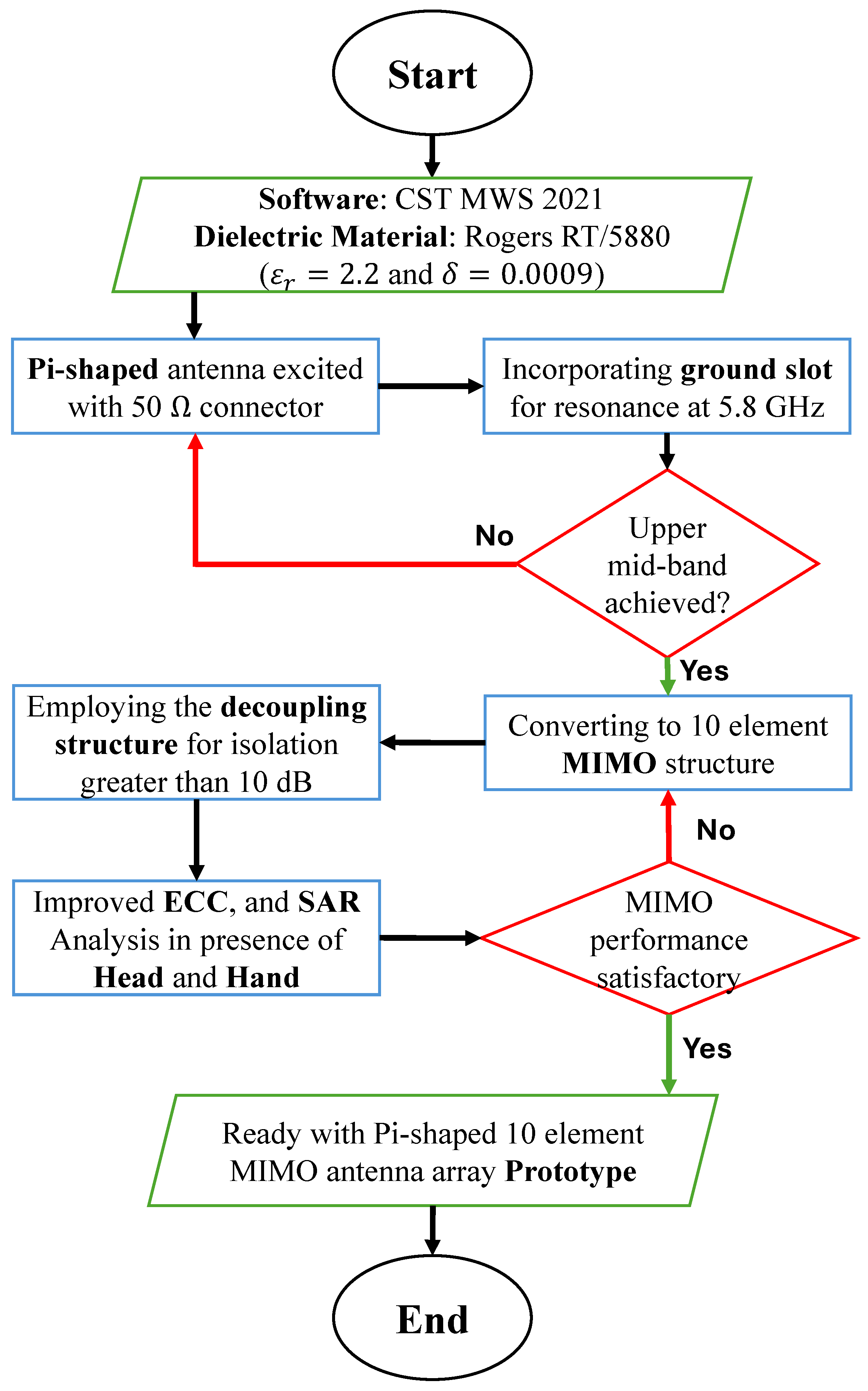


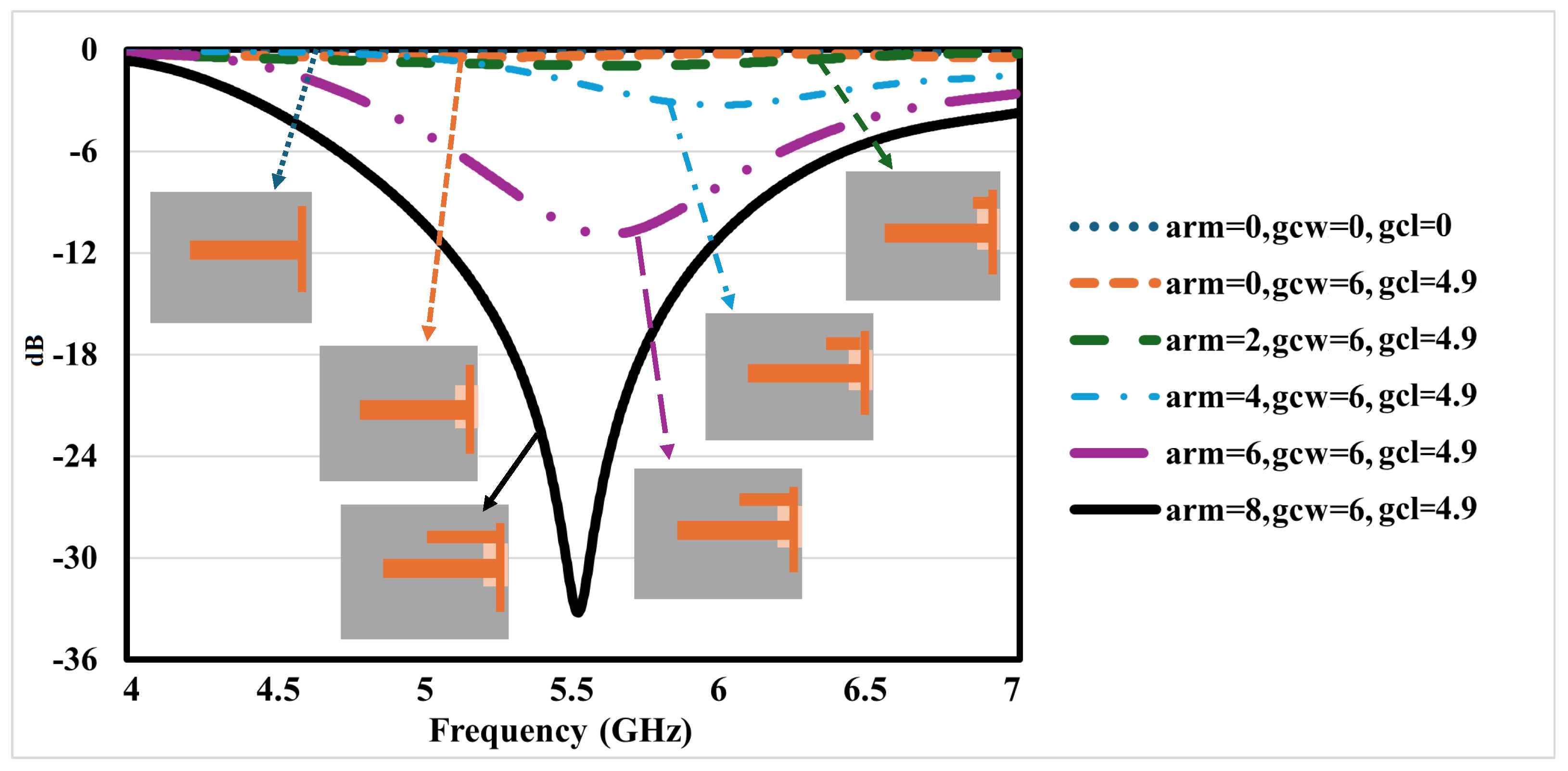

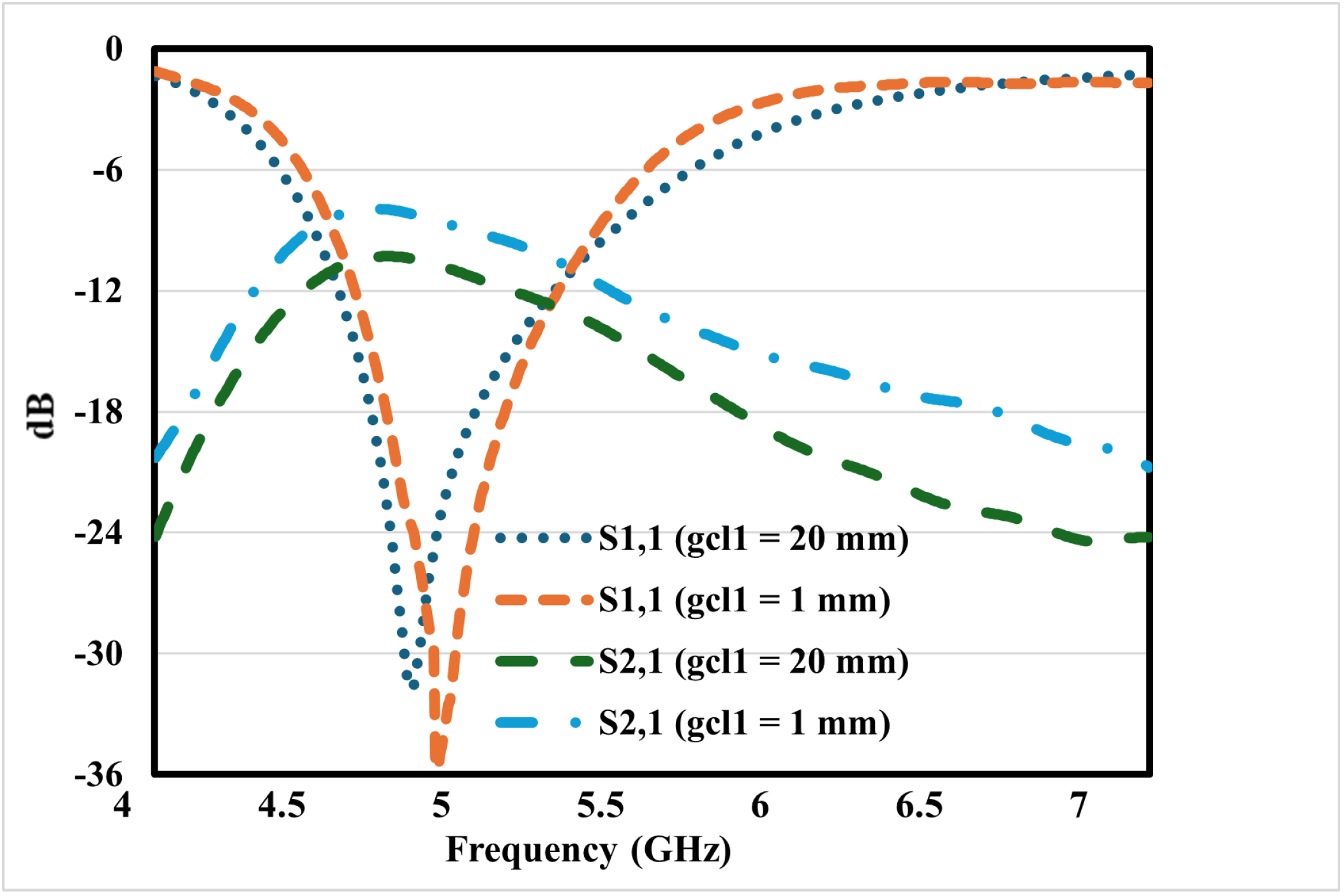
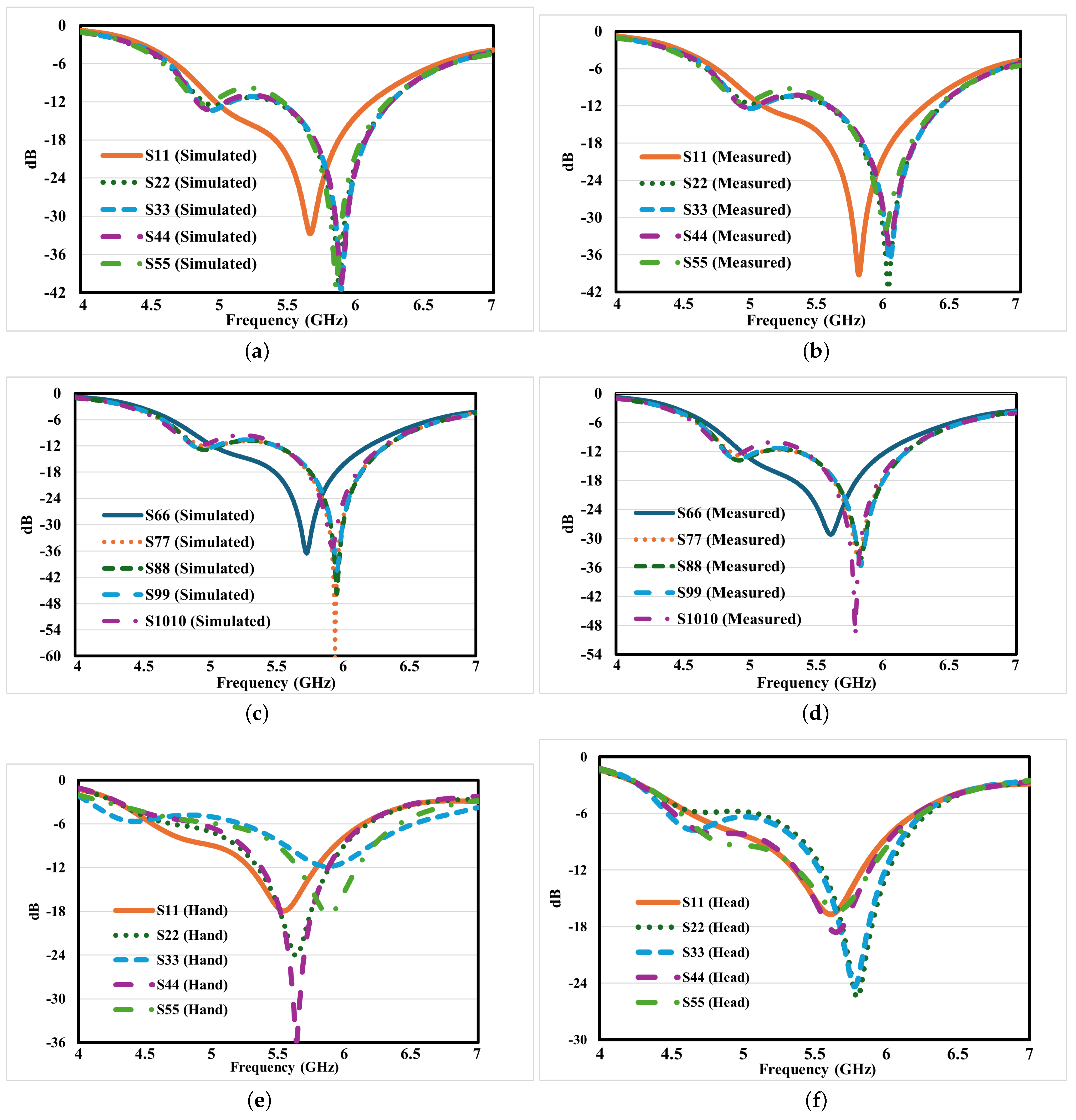



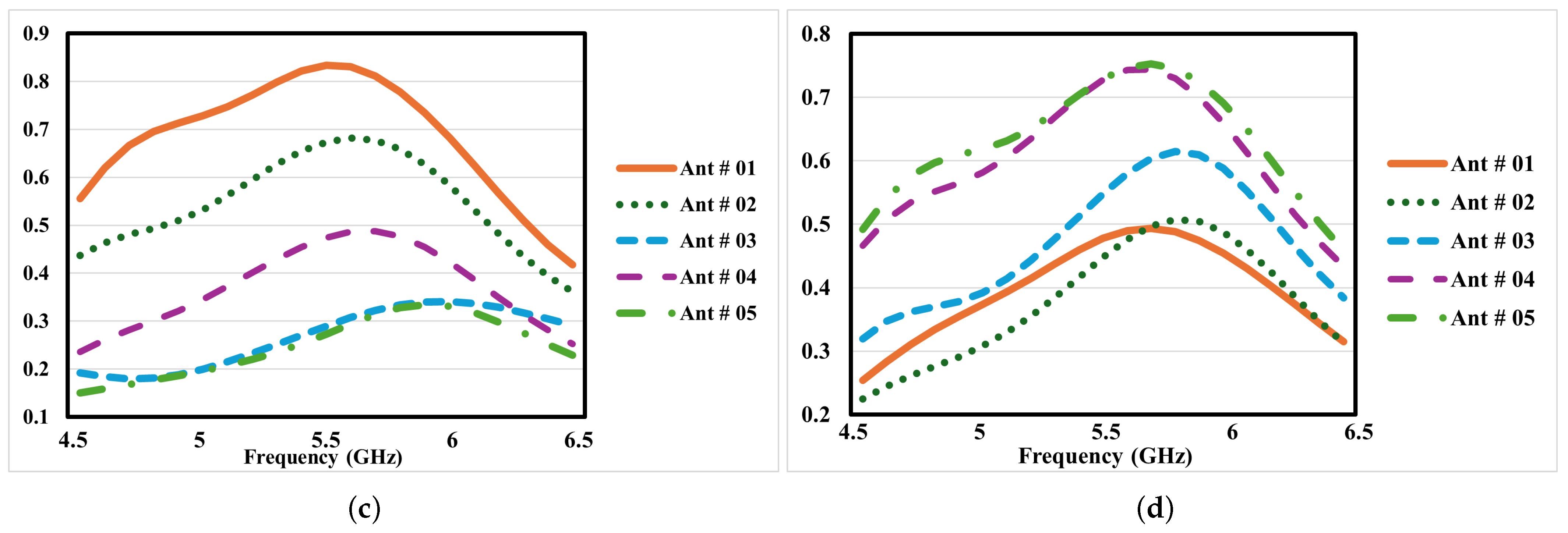
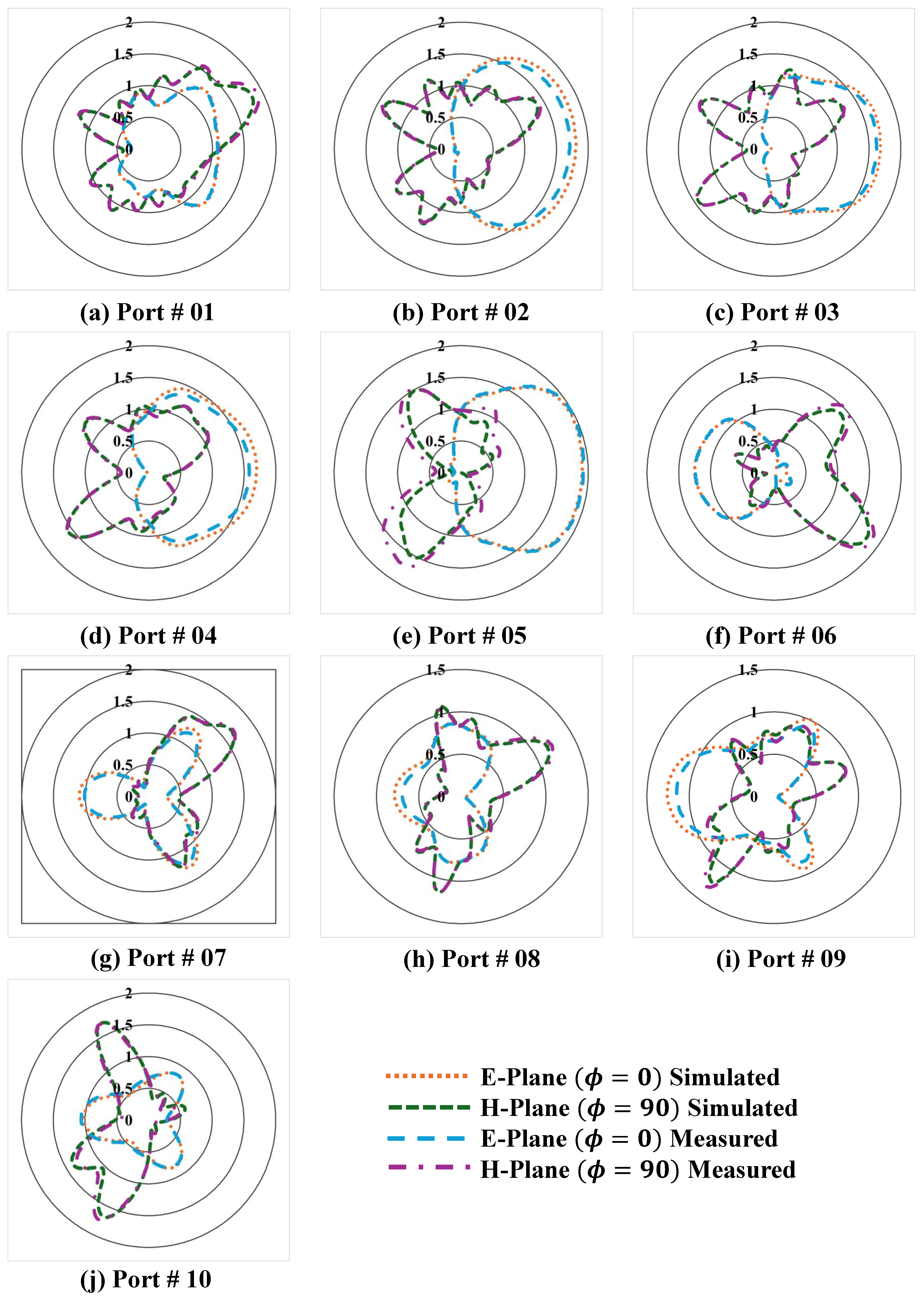




| Variable | Dimension (mm) | Variable | Dimension (mm) | Variable | Dimension (mm) |
|---|---|---|---|---|---|
| sl | 125 | sw | 70 | spacing | 25 |
| pl | 7.5 | fl | 13 | fs | 2.63 |
| gcw | 6 | gcw1 | 1 | gcs | 2.085 |
| gcl | 4.9 | gcl1 | 20 | arm | 8 |
| gap | 1.5 | gap1 | 14.915 |
Disclaimer/Publisher’s Note: The statements, opinions and data contained in all publications are solely those of the individual author(s) and contributor(s) and not of MDPI and/or the editor(s). MDPI and/or the editor(s) disclaim responsibility for any injury to people or property resulting from any ideas, methods, instructions or products referred to in the content. |
© 2025 by the authors. Licensee MDPI, Basel, Switzerland. This article is an open access article distributed under the terms and conditions of the Creative Commons Attribution (CC BY) license (https://creativecommons.org/licenses/by/4.0/).
Share and Cite
Zahid, M.; Amin, Y. Specific Absorption Rate Analysis of Wideband Multiple-Input Multiple-Output Antennas for Upper Mid-Band LTE 46/47 and n102 Future Generation Applications. Telecom 2025, 6, 22. https://doi.org/10.3390/telecom6020022
Zahid M, Amin Y. Specific Absorption Rate Analysis of Wideband Multiple-Input Multiple-Output Antennas for Upper Mid-Band LTE 46/47 and n102 Future Generation Applications. Telecom. 2025; 6(2):22. https://doi.org/10.3390/telecom6020022
Chicago/Turabian StyleZahid, Muhammad, and Yasar Amin. 2025. "Specific Absorption Rate Analysis of Wideband Multiple-Input Multiple-Output Antennas for Upper Mid-Band LTE 46/47 and n102 Future Generation Applications" Telecom 6, no. 2: 22. https://doi.org/10.3390/telecom6020022
APA StyleZahid, M., & Amin, Y. (2025). Specific Absorption Rate Analysis of Wideband Multiple-Input Multiple-Output Antennas for Upper Mid-Band LTE 46/47 and n102 Future Generation Applications. Telecom, 6(2), 22. https://doi.org/10.3390/telecom6020022








